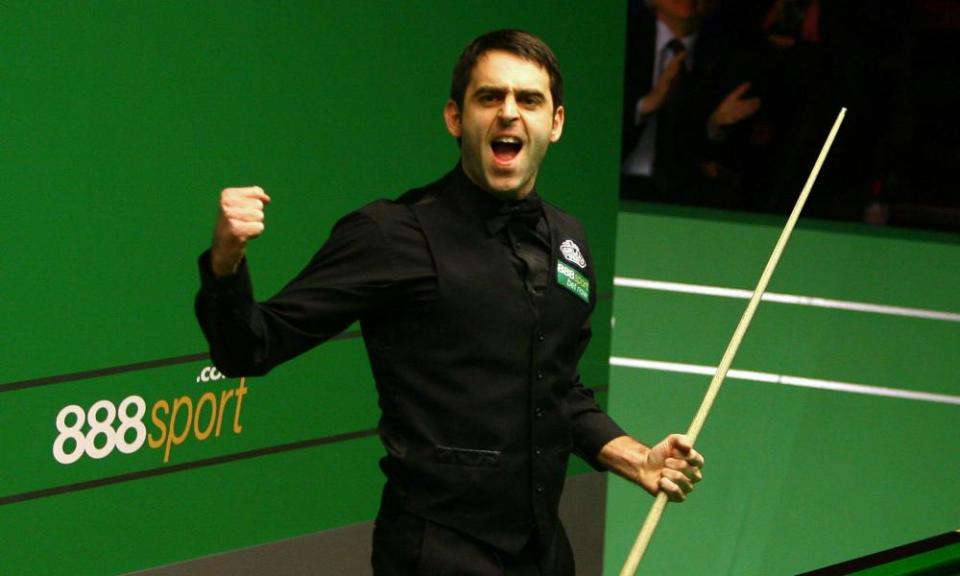Barry Hearn ups stakes in attempt to solve mystery of missing maximums

The 2018 snooker world championship has gone off like a rocket. Mark Selby, the champion of the past two years, has been comprehensively beaten in the first round, 10-4 by Joe Perry. Ronnie O’Sullivan had to mount a mighty comeback himself, winning seven of the final eight frames to knock out Stephen Maguire 10-7. The opening weekend has already made the matter of who will claim the title an open one but it is not the only intriguing question at the Crucible this year.
Two weeks ago the sporting impresario Barry Hearn, who among other things has a controlling interest in the commercial operations of snooker’s governing body, announced he would be raising the prize money for a 147 maximum at the Crucible this year. The bonus, which had been based on a slightly complicated rollover system with a minimum reward of £5,000, will now default to £40,000. It is a big raise to counter a striking anomaly: in recent years snooker has gone 147‑loopy everywhere bar the world championship.
The basics of the snooker maximum require a player to make a clean sweep of the table, with every red that is potted being followed by a black. Established in the 1870s, with the first world championship taking place in 1927, snooker’s first recorded maximum came in 1955. It was scored by Joe Davis, the 15‑times world champion, and took two years before it was officially recognised. The first maximum in professional competition, meanwhile, did not come until 1982 when Steve Davis made the score in the Lada Classic in Oldham. To commemorate his accomplishment Davis was presented with a Lada with the customised numberplate of SD 147.
The story of the snooker maximum accelerated from that point. To date there have been 139 scores of 147 in professional snooker. Of that total 70 have come since the turn of the decade and three have come in the past four weeks. The Chinese player Liang Wenbo scored one in world championship qualifying and nearly reached another two frames later, only to fail on the final black.
O’Sullivan has the most 147s of any player, 14. The total includes the most feted maximum of all, scored against Mick Price in the first round of the 1997 world championship, a feat which took five minutes and 20 seconds to complete. When Sullivan made that break he was rewarded with a bonus of £147,000. Given the increasing frequency of the achievement, it is perhaps not surprising the prize money shrank. But there has not been a maximum at the world championship since Stephen Hendry cleaned the table against Stuart Bingham in 2012. The appetite to see an end to the barren run even led to O’Sullivan being suspected of having swerved one on purpose last year. Potting a pink after the final red when – in some eyes – it was possible for him to have screwed back for the black, Sullivan’s actions were deemed a protest against the insubstantial prize pot.
After that controversy Hearn was telling the players that, if they found the bonus money insufficient, they should play another sport. But this year he has changed his mind. So why has the 147 gold rush been staunched at the Crucible? Is it down to the money? Not according to John Parrott, the former world champion and now a BBC pundit. “I think there are two reasons why it hasn’t happened,” he says. “The first is that there are more top-class players than there used to be. The second is that it’s bloody hard. You’re asking someone to do the hardest thing in the sport in the ultimate arena in the biggest tournament and in front of the biggest audience.”
According to Parrott the psychological factor is paramount in a competition aficionados like to call “the marathon of the mind”. But the opportunity to score comes round a lot less often, too. “To score a maximum is far harder than, for example, hitting a nine-dart finish,” Parrott says. “And at the Crucible you get fewer chances. There’s so much high-quality safety play. The balls don’t go the way you think, people don’t play off the sides. They try to keep the reds together. The opportunity to open up doesn’t come every day of the week.”
The other side of the coin is that a rise in standards – “if you’re not professional, this game will find you out,” Parrott says – means there are more players capable of breaking the 147 duck in Sheffield over the next two weeks. With the champion already deposed one name has been scratched from the list, but few would rule out the iconoclastic O’Sullivan from rising to the challenge. As for Parrott, he is confident too. “If you gave me a free £10 bet,” he says in an adaptation of the old ‘I’m not a betting man...’ formula, “then I would be more inclined to say yes. The field is just so strong this year.”

 Yahoo Sport
Yahoo Sport 





































